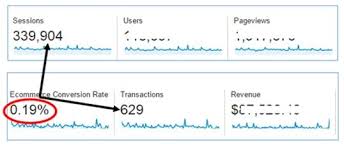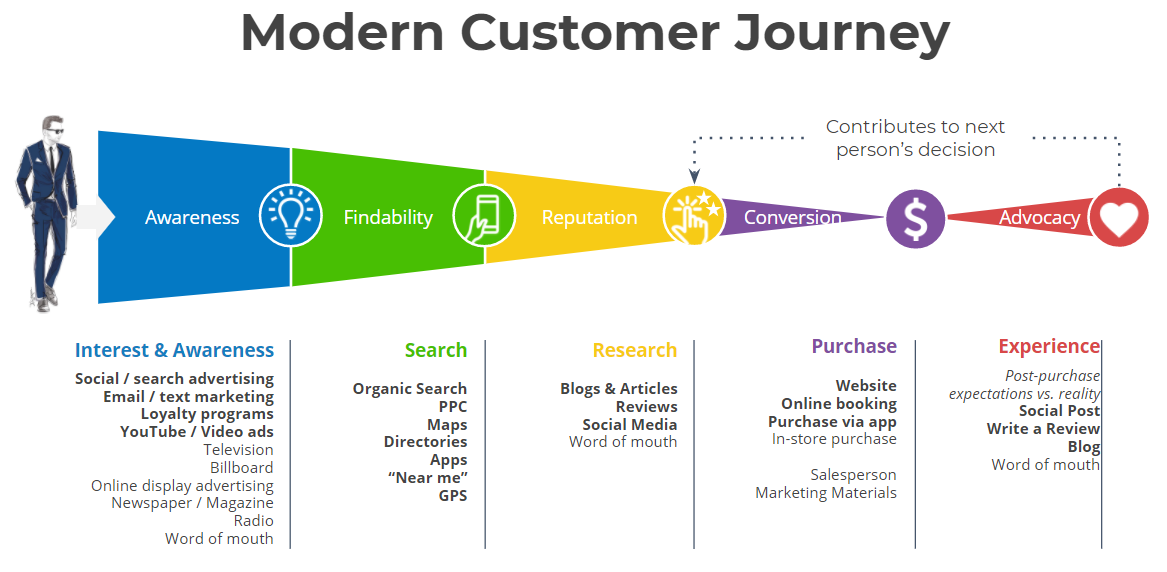Getting The Most Out of Google Analytics

At Ticketsolve we are big advocates of Google Analytics as it gives you really powerful data that you can actually use to sell more tickets. Because of this, we have built an in-depth integration with Google Analytics (I’ll call it GA from now on as it's a long word to keep typing!) that allows our customers to really understand how their customers interact with their website.
The Main Stat
94% of people who use GA only look at the first report which is the Audience report. This report shows how many people visited the website, how long they were there for and other ‘visit’ related data. Okay, don’t look that 94% stat up - I might have pulled that number out of the air :) But it is a REALLY high percentage of people that only look at the audience report and move on.
The point is you need to start looking at the more juicy stuff, and it doesn't get much juicier than the e-commerce conversion rate!!
This is the first stat you should be looking at. It gives you a real indication as to how many people are purchasing tickets on your website. A lot of venues don’t have the capability of looking at this stat as their current box office system hasn’t got a full integration with GA, but don’t worry, Ticketsolve has you covered! ;)
So, what is the e-commerce conversion rate? Basically, it is the percentage of people who come onto your website and end up buying a ticket. According to Blacktype Digital and Google Partners, the average conversion rate in the ticketing industry is 1-2%. So that means for every 100 people who come onto your site, only 1 or 2 people will end up buying a ticket.

You compare that to our customers’ averages and it is mindblowing. For some of our customers, their conversion rates are over 6%. This shows that their website combined with the Ticketsolve booking journey works very effectively and is really efficient.
Enhanced Ecommerce

Staying with e-commerce for the moment, the enhanced e-commerce data you can get from GA is brilliant. Helped by the groundwork of our developers, the enhanced data is fantastic as it can show you how the customer moves through the booking journey. The graph below shows how customers come onto the website, and move through the booking funnel to finally purchasing their tickets. The main stat we are looking for within this report is the cart abandonment rate - this is the number of people that leave the purchasing flow after they have added tickets to their cart. The average drop off rate is around 78% however, in our industry this will be slightly lower. Some of our customers see their drop off rates as low as 25% and this again shows the simple booking process that Ticketsolve has really works.

Where Are My Customers Coming From?
Another great report, especially for the marketing teams is the Acquisition report. This will show you where your customers are coming from - e.g. Facebook Campaigns, Google Search, Twitter Links, etc. But, because we have a full enhanced integration with GA, you will also be able to see how much revenue has been generated from each of those locations. Cool, eh! If you use MailChimp, this also has an e-commerce integration with GA, so when you send your emails out, they are automatically added as a campaign in GA so that you can track exactly how successful it is.
Top Tip: Check out our blog on Google Url Builder for you to track all digital marketing campaigns.
What Are My Customers Using?

A very good data point to look at is how customers are visiting your website and what devices they use to purchase their ticket. The mobile report shows you exactly that, how many people visit your website using a mobile, and more importantly how much revenue is being spent on each device. In the next year or so, we envisage that 80% of all online sales will be made on mobile. Some of our customers are already seeing their mobile sales accounting for 70% in some areas. Again, this shows that because Ticketsolve is responsive, the purchasing journey for customers is seamless; they are not faced with obstacles or frustration when trying to make bookings on mobile.
Demographics
Demographics in GA is a hidden gem in our eyes. Google can tell you (quite accurately) the demographics of customers visiting your website. When looking at it for ‘all customers’ it is good data to have. But when you delve deeper and look at specific segments such as ‘everyone who purchased for a comedy show’, it’s great data! Couple that info with how customers are purchasing on PC, mobile and tablet, and you can really start to adapt your digital strategies around these data points.
Summary
We hope you’ve found this blog useful and that you will start looking at these data points in more detail from now on. In summary, the reports that we think you should be looking at in detail are:
-
E-commerce Conversion Rates
-
Enhanced E-commerce Shopping Behaviour
-
Acquisition by Source and Medium
-
Device Category
-
Demographics
You will probably begin looking at these reports as a whole, with all your customers in the segment, but it is good practice to start using segments so that you see how certain demographics interact with your website. All this information can then be brought into your digital marketing strategy and will start to drive your goals and objectives, and more importantly, will increase your ticket sales.
Categories
Recent posts
Archive
- December 2025 (2)
- November 2025 (1)
- October 2025 (3)
- September 2025 (1)
- August 2025 (3)
- July 2025 (3)
- June 2025 (3)
- May 2025 (4)
- April 2025 (5)
- March 2025 (5)
- February 2025 (4)
- January 2025 (4)
- December 2024 (3)
- November 2024 (5)
- October 2024 (4)
- September 2024 (7)
- August 2024 (5)
- July 2024 (3)
- June 2024 (3)
- May 2024 (3)
- April 2024 (3)
- March 2024 (4)
- February 2024 (5)
- January 2024 (3)
- December 2023 (3)
- November 2023 (4)
- October 2023 (4)
- September 2023 (5)
- August 2023 (3)
- July 2023 (4)
- June 2023 (4)
- May 2023 (5)
- April 2023 (4)
- March 2023 (4)
- February 2023 (5)
- January 2023 (4)
- December 2022 (4)
- November 2022 (3)
- October 2022 (4)
- September 2022 (5)
- August 2022 (2)
- July 2022 (4)
- June 2022 (5)
- May 2022 (4)
- April 2022 (5)
- March 2022 (3)
- February 2022 (4)
- January 2022 (4)
- December 2021 (2)
- November 2021 (3)
- October 2021 (5)
- September 2021 (4)
- August 2021 (4)
- July 2021 (3)
- June 2021 (4)
- May 2021 (2)
- April 2021 (4)
- March 2021 (5)
- February 2021 (4)
- January 2021 (5)
- December 2020 (4)
- November 2020 (4)
- October 2020 (5)
- September 2020 (5)
- August 2020 (4)
- July 2020 (7)
- June 2020 (5)
- May 2020 (5)
- April 2020 (5)
- March 2020 (8)
- February 2020 (4)
- January 2020 (5)
- December 2019 (3)
- November 2019 (5)
- October 2019 (4)
- September 2019 (4)
- August 2019 (5)
- July 2019 (4)
- June 2019 (4)
- May 2019 (5)
- April 2019 (4)
- March 2019 (4)
- February 2019 (3)
- January 2019 (5)
- December 2018 (4)
- November 2018 (8)
- October 2018 (2)
- September 2018 (3)
- August 2018 (5)
- July 2018 (4)
- June 2018 (4)
- May 2018 (1)
- April 2018 (1)
- March 2018 (3)
- February 2018 (2)
- December 2017 (2)
- November 2017 (3)
- October 2017 (4)
- September 2017 (2)
- August 2017 (1)
- July 2017 (5)
- June 2017 (3)
- May 2017 (2)
- April 2017 (3)
- March 2017 (2)
- February 2017 (3)
- January 2017 (3)
- December 2016 (4)
- November 2016 (1)
- September 2016 (1)
- July 2016 (3)
- June 2016 (1)
- May 2016 (2)
- April 2016 (2)
- February 2016 (1)
- January 2016 (3)
- December 2015 (2)
- September 2015 (1)
- August 2015 (2)
- July 2015 (1)
- June 2015 (2)
- May 2015 (2)
- April 2015 (5)
- March 2015 (2)
- February 2015 (2)
- January 2015 (4)
- December 2014 (3)
- November 2014 (3)
- October 2014 (2)
- September 2014 (3)
- August 2014 (3)
- July 2014 (3)
- June 2014 (7)
- May 2014 (6)
- April 2014 (3)
- March 2014 (2)
- February 2014 (1)
- January 2014 (3)
- December 2013 (1)
- August 2013 (1)
- June 2013 (1)
- April 2013 (1)
Sign up for regular updates


